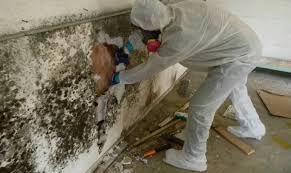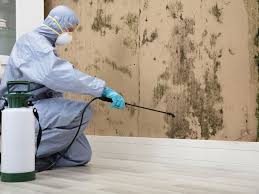How to Identify and Treat Mold in Your Basement
If any place in the house will grow mold, it’s the basement. Basements collect and trap moisture, and moisture is one factor that leads to mold growth. And because basements have less natural light and airflow than other parts of the home, that mold will not die off on its own.
Some strains of black mold can be a health hazard. Plus, mold can quickly decay organic materials such as wood, leading to structural failure. This means that identifying and treating mold in the basement should be a priority as soon as you believe that you have it.
Mold in the Basement: Identifying and Treating It
Homes that have basements often have mold. Due to basements’ proximity to groundwater, water can wick up through concrete floors and continue wicking up through floor sleepers and wall studs. Homes without a robust water diversion system may accumulate water in the soil that can crack the foundation, which results in water leakage.
Identifying and treating basement mold is a multi-stage process:
Finding the basement mold.
Testing for mold.
Removing structural elements to permit access to the mold, as needed.
Killing the mold.
Mechanically removing or encapsulating the dead mold spores.
Fixing the problem that led to mold growth.
Codes, Regulations, and Permits
Most communities do not have laws that monitor mold or enforce mold removal. However, always check with your local permitting office to see if permits are required for mold removal.
When to Treat Mold in the Basement
Remove mold in the basement as soon as possible to prevent its further growth. If the basement has recently been flooded, first remove all of the water and wait until the basement is completely dry before you begin removing the mold.

How to Clean Black Mold
The kind of black mold that shows up in houses and buildings is directly related to a medical problem known as sick building syndrome, according to the American Industrial Hygiene Association. To remove black mold, you’ll need to figure out why the mold is there in the first place, fix that problem, and take the necessary steps to eliminate it completely.
Target the Source
Mold grows in wet environments, so it’s important to find out where the condensation is coming from and fix the problem—whether it originates from a leak, improper ventilation, or blocked drainage. If you remove the mold without taking steps to dry up that space, it will come back. Once you fix the underlying issue, you are ready to clean up the black mold.
Protect Yourself With Gear
Before you start, make sure you have the appropriate tools. You’ll need:
A respirator or face mask rated for black mold protection
Heavy plastic to seal off the area and contain waste materials
Heavy-duty plastic bags to collect wall material
Duct tape to secure the plastic
Fan
Spray bottle with water to wet down dry areas to prevent mold spores from getting into the air
Pump mist sprayer filled with water to wet down larger areas
Wood preservative
Bucket
Bleach or an Environmental Protection Agency-registered disinfectant cleaner
Water
Appropriate paint and painting tools
After securing the area with plastic and a fan if necessary, put on your face protection and get to work. You’ll also want to cover as much of your skin as possible to prevent the mold from touching you. When closing off a room, make sure to cover both the doorways and air vents with the plastic. If possible, place the fan in a window to help vent the room.
Gauge the Size of the Job
Sometimes surface mold goes deeper than you think. Look closely at carpeting and padding, floorboards, drywall, and insulation. You need to know how widespread the infestation is to properly plan the removal and restoration.
Mold-Resistant Drywall Review: Pros and Cons
Mold and mildew growth have become a hot-button issue lately due to health concerns. Mold remediation companies deal with eliminating mold/mildew, but it’s always best to prevent mold before it starts. One potential weapon in the mold-prevention arsenal is mold-resistant drywall, a product marketed aggressively by manufacturers. When installed in homes, it is often touted by real estate professionals as a selling feature.
Preventing Mold Growth on Drywall
To grow, mold spores require oxygen, moisture, and an organic food source. In the case of gypsum wallboard, that organic material is found in the paper facing on the drywall panels (the gypsum core is non-organic and not subject to mold).
Preventing mold growth on drywall can be approached via two strategies:
Deny mold spores the required air and moisture. With some mold-resistant drywall, this is accomplished by using a thicker paper facing and backing that is heavily saturated with a waxy substance that prevents moisture and air from getting at the paper. Without this, mold spores can not take root.
Use a material other than paper for the outer layer on the drywall panels. This form of mold-resistant drywall typically uses fiberglass mesh instead of paper for the facing and backing. Because fiberglass is a non-organic material, mold has no food source necessary to colonize for it to colonize.
Increasingly, mold-resistant drywall is also marketed as moisture-resistant wallboard, and where manufacturers once offered two different drywall products—one for mold resistance, one for water-resistance—most products now incorporate both merits. It is important to note that manufacturers never guarantees their product as being immune to mold—only resistant to it.
Mold-Resistant Drywall Cost
Modern mold-resistant drywall that also includes moisture-resistance is about 50 percent more expensive than standard drywall. Big box home improvement centers sell a sheet of 1/2-inch, 4 x 8-foot standard drywall for about $12 per sheet, while a comparable sheet of good mold-resistant drywall costs about $16. Buying in bulk will notably reduce this price.

How to Make Concrete Molds from Wood
Molding concrete is made easy for do-it-yourselfers with wood forms that create the perfect shape. Instead of setting the concrete in place, you can cast the concrete in a convenient location like a patio or garage. You don’t even have to worry about troweling the top smooth. The form does most of the work for you. The concrete is cast upside-down, so the mold’s smooth bottom becomes the concrete’s top.
Basics of Making Concrete Molds From Wood
Start With a Coated Surface
Uncoated wood is routinely used to make large molds for curbs and house footings. After curing, the concrete will unstick from the wood relatively easily. But using wood coated with a slick surface will make the release even easier. For this, 3/4-inch thick MDF board topped with melamine is ideal.
Use an Inexpensive Disposable Wood
After being used for molding concrete, the melamine board is often too crusted with concrete to be reused. Melamine-faced board is inexpensive and can be discarded after use.
Use a Release Agent
To aid the release of the concrete from the mold, coat the surface with a release agent. Cooking spray, motor oil, vegetable oil, and dishwashing detergent mixed with water (1:10 ratio) are a few of the release agents available around the home. Or you can use a product designed solely for this purpose, such as a spray or brush-on silicone-based, semi-permanent sealer and release agent.
Use Exposed Removable Fasteners
When building the mold, construct it with fasteners that are easy to remove. Screws are perfect for making a mold because they can be turned out. The heads should be exposed, too. If a fastener’s head is embedded in the concrete, you will not be able to access it to remove it. Face-screw the fasteners—no need to sink them into pocket holes.
How to Fix Water Problems in the Crawl Space
Water in your home’s crawl space is more than just an annoyance; it can have devastating consequences for your home’s value and for your health. Standing water or even ever-present moisture in the air can create mold problems that lead to chronic health issues for your family. At the extreme end, water in a crawlspace can lead to rot and decay that weaken structural members and make major architectural repairs necessary. The presence of moisture can also foster termites, carpenter ants, and other insects that can damage your home and affect your quality of life. Water under the house attracts animals that you really want to avoid such as rats and raccoons.
When to Fix Water Problems in the Crawl Space
Water can sit in the crawl space for months, even years, giving a false impression that everything will be fine as long as you own the house. Over the long term, though, standing water can damage the house’s foundation; wooden beams and joists will begin to rot; various strains of mold can develop. You will be required to fix the problem when it comes time to sell the house. A future buyer will be unable to obtain a loan to buy a house with water problems in the crawl space.
Water remediation is a project best handled during dry months. While all of the work is done in protected environments such as in the house or under the house, water can continue to build up under the house and hamper work.
Safety Considerations
Working under your home can present many hazards. Dust, dried feces, black mold, and asbestos are only a few of the contaminants you might breathe in this space. Wear breathing protection in the crawl space.
The general process of controlling water in a crawl space involves setting up a perimeter within the crawl space and capturing any water that tries to infiltrate that perimeter. When water hits this border, it is diverted into gravel-filled channels and fed by gravity to a sump pump pit. The sump pump then pumps the water from the crawl space